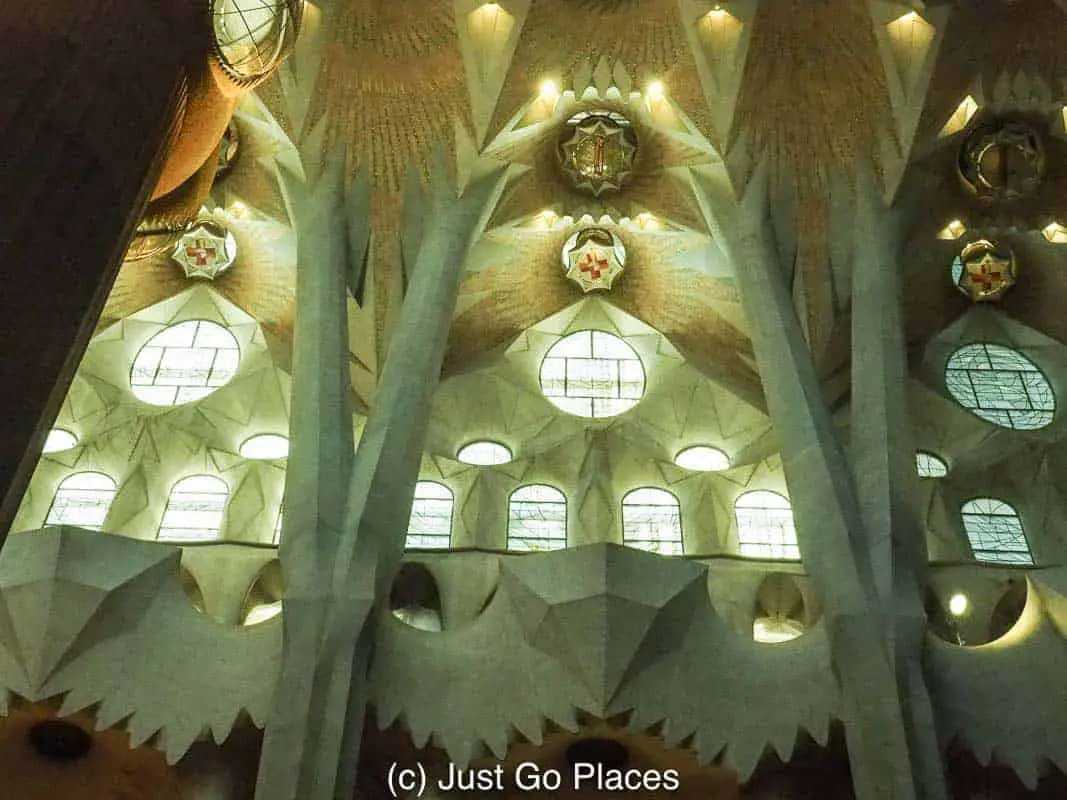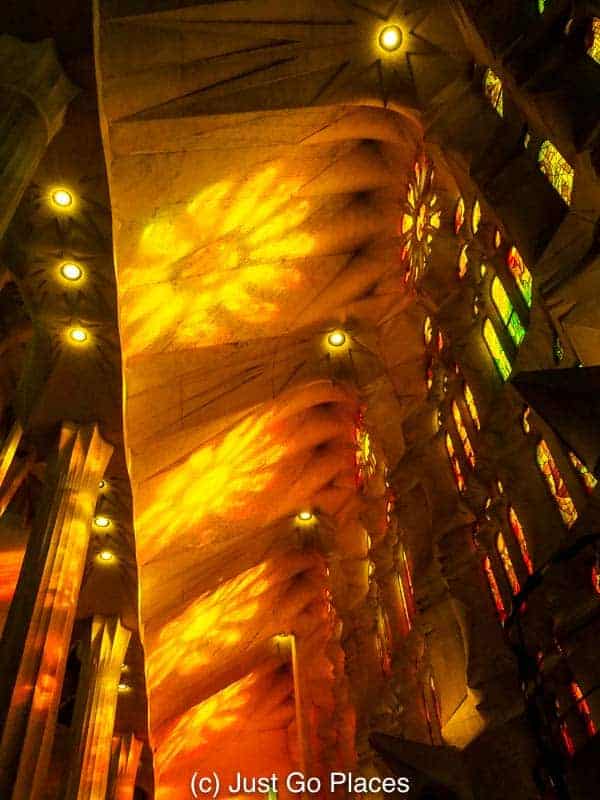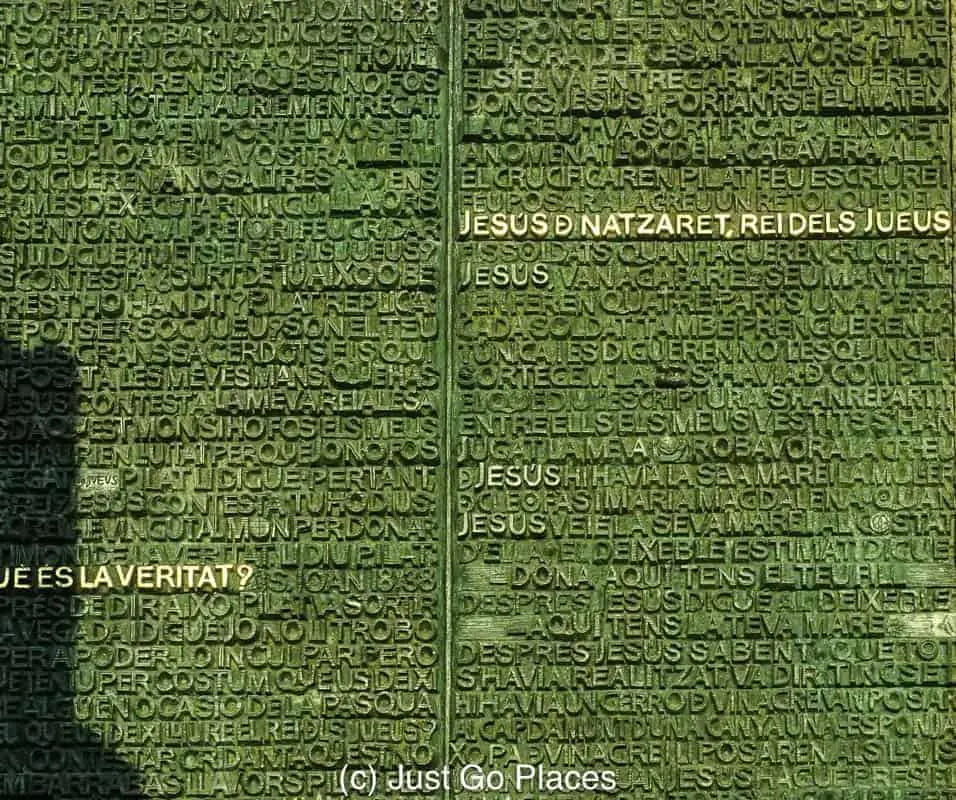Artists do not need monuments erected for them because their works are their monuments.
– Antonio Gaudi
When I went to check out the most famous church in Barcelona, La Sagrada Familia, exactly 20 years ago this year, my visit was very different from my recent trip. Unlike today only the Nativity facade was finished back then. There was no line to get inside this Barcelona church because there really wasn’t much of an interior. I climbed part of a tower and surveyed the construction site. Even then, the grand proportions of the Sagrada Familia made the church a cool, if empty, space. Antonio Gaudi’s final masterpiece would far outlive him and skyrocket his name into the echelons of history. When we visited Barcelona with the kids a couple of years ago, I did not anticipate the huge lines. On this recent visit, though, I was smart and booked tickets ahead of time.
Contents
What makes La Sagrada Familia Special
Barcelona is the most visited city in Spain. Many of its millions of visitors make two obligatory stops – La Boqueria, the famous market of the Ramblas for food, and La Sagrada Familia, for some culture. You can easily visit both places on a 2 day itinerary for Barcelona.
The Barcelona church of La Sagrada Familia gets some 3 million visitors annually.
The expiatory church of La Sagrada Família is made by the people and is mirrored in them. It is a work that is in the hands of God and the will of the people.
– Antonio Gaudi
Some Fun Sagrada Familia Facts
Timeline for La Sagrada Familia
- Gaudi accepted that La Sagrada Familia is a long-term project that he would not live to see completed.
- Gaudi’s masterpiece is an expiatory church which means that it is built with donations from the public. Now that visitor numbers, and related ticket sales, have increased, the church receives about 25 million Euros a year.
- There are still 4 central towers to be built which will reach 170+ metres and let light into the interior. The current towers that you see will be dwarfed by these new towers because they are only 98 metres in height.
- The really tall towers will stand just underneath the height of nearby Montjuic. Gaudi did not want his work to rise taller than that of God.
The Sagrada Familia Interior
- The Sagrada Familia interior has a pleasing symmetry because Gaudi created it in multiples of 7.5 metres.
- As an architect, Gaudi did not want a giant altar piece obstructing the view of his architectural lines. Many people are taken back by the simplicity of the altar piece. You get a giant cathedral and a small altar.
- The inside of the Sagrada Familia is supposed to be an homage to nature, a garden forest rising up to the skies.
- The inside is practically bereft of statues except for the Holy Family and the local patron saint. Gaudi really wanted very little distractions inside the church.

You can see the colors mixing in the purple light cast by the blues from the windows in one side and the reds cast from the other side.

The stained glass is a secondary glazing technique that goes over the windows. These windows have not been finished with the stained glass topping yet.
The Nativity Facade
- The Nativity Facade was completed during Gaudi’s lifetime because he wanted to show people his vision in the hopes that they would donate money.
- Gaudi liked to use real people to model his figures. The soldier in the scene depicting the killing of the innocents was the local butcher. The butcher had 6 toes on one foot, a detail which was faithfully recreated on the sculpture.
- Check out the bottom of the pillars of the Nativity entrance. One rests on a turtle and another on a tortoise, a land based and a water based animal. This subtle reference to the two sides of life in Barcelona the mountains and the sea was a nod to his benefactors.
- The Nativity facade overflows with references to birth and nature – such as the Cypress tree used to represent the tree of life.

It’s hard to know where to look on the Nativity facade. This bit depicts the angel Gabriel appearing to Mary announcing she is pregnant with Jesus.
The Passion Facade
- Gaudi himself was the second lead architect. The church is now on its 9th lead architect who leads a team of 20 architects. People joke that there could be a 10th architect soon because the current architect is embroiled in a dispute over his mosaic design on the Passion facade. The other architects think the mosaic does not fit in with Gaudi’s mournful vision for the Passion facade.
- Gaudi’s profile is immortalised in the Passion facade.
- Architects used the oil painting technique of chiaroscuro which creates light and shadow to convey the sadness of the scene.
- Catalan sculptor Joseph Subirach created the giant doors with words from the Bible.
Antonio Gaudi’s Masterpiece
Gaudi’s Vision For His Barcelona Church
Even though Gaudi had a clear vision for La Sagrada Familia, he accepted that you could not reign in an artist’s creativity. He left instructions that allowed future artists to have a certain amount of leeway in how his vision would be interpreted.
There is no reason to regret that I cannot finish the church. I will grow old but others will come after me. What must always be conserved is the spirit of the work, but its life has to depend on the generations it is handed down to and with whom it lives and is incarnated.
– Antonio Gaudi
- During the last 10+ years of his life, Gaudi worked feverishly to leave models, drawings etc for how the Sagrada Familia should look. He actually lived in his studio at the Sagrada Familia.
- Gaudi created clouds in his vision for the 3rd facade, the Glory facade, which is still to be completed. The Glory facade represents the risen Jesus in heaven with clouds floating around.
- Architects though have no idea how to create floating clouds like he intended. Gaudi assumed technology would have caught up with his vision – they still have 9 years to figure it out if they want to make the 2026 self-imposed deadline.
- The door at the Glory facade is the only part that is finished. Created by Catalan sculptor, Josep Subirach, the door depicts the Lord’s Prayer in 50 different languages.
During the Spanish Civil War happened, the Spanish Catholic Church had a vested interesting in protecting its own wealth and influence. They sided with Franco’s Fascists against the Republicans. In response, Republican rioters destroyed churches including Gaudi’s workshop at the Sagrada Familia. Post-destruction, architects were left to piece together what Gaudi had wanted to do from the rubble.
How did Gaudi die?
Gaudi is buried in a crypt which can be seen in the museum adjoining La Sagrada Familia. The crypt is actually in the basement equivalent of the church which was completed by the first architect. So, ironically, the area where Gaudi is buried is not his creation although the structure above his tomb is.
Gaudi had an unfortunate and accidental death. He was run over by a street car on the way to church on a Sunday. When his workers arrived at La Sagrada Familia on the Monday, no body could find him. When they searched for him, they discovered his unidentified body.
Everyone is working at top speed to finish La Sagrada Familia so that it is finished in 2026, the centenary of Antonio Gaudi’s death. Considering the middle towers aren’t even built yet, and they are building with crowds of tourists all around, the most famous church in Barcelona has plenty of work left.
The Most Famous Church in Barcelona
I’m just going to assume that if you go to Barcelona you will visit La Sagrada Familia. Everyone does for good reason. Here are some tips to help you get the most out of your visit.
La Sagrada Familia Tickets
Keep in mind the time of day.
Keep in mind that the best light for the church occurs at the extremes of the day. The morning sun lights up the cooler blues and greens of the stained glass East windows. The afternoon sun sets off the fiery oranges and reds of the the west windows. When the afternoon sun is low enough, the light reaches across the entire cathedral mixes with the blues and greens to create shades of purple.
Buy tickets ahead of time.
I highly recommend that you buy tickets ahead of time for visiting La Sagrada Familia. In low season, the tickets are easy to book a day or so ahead of time.
You need to allow longer in peak season especially on a Saturday or Sunday. During the summer season, the cruise ships come into Barcelona port depositing 14,000 visitors at a time. The most famous church in Barcelona is also one of its most visited sites. You really don’t want to stand in line for an hour or two in the scorching summer heat.
You will need to pick between types of tickets etc.
There are a handful of different types of Sagrada Familia tickets. They range from the basic €15 ticket to the church to the €29 ticket which includes a trip up a tower to get panoramic views of the city. I bought only the basic ticket and regretted it. You can also get tickets that have an audio tour or a guided tour. I have heard the audio tour is excellent – enough information without going into too much detail.
Practical Info To Know Before You Go
We stayed by the seaside Barcelona at the 5 star Hotel Arts. This famous hotel is justifiably lauded – the service is great, the location convenient and the views fantastic.
On previous trips we have stayed at the 4 star Hotel Royal Ramblas located conveniently on the Ramblas. My children really enjoyed the lounge with its huge windows where you can watch all the action on Las Ramblas.
We have also stayed at the Grand Hotel Central, a 5 star hotel, with an incredibly convenient location. The hotel is a 5 minute walk from the Cathedral, sandwiched between the Gothic Quarter and the trendy Born District and an easy walk to the beach.
In the summer heat, you will appreciate a cool dip in a pool after a day’s sightseeing. I can’t think of many better ways to enjoy the end of another fabulous day than at one of the hotels in Barcelona with rooftop pools!
I chose to take a guided tour with Context Travel. I paid full price for my Sagrada Familia Context Tour which I was happy to do so because I think they are worth it.
SPREAD THE WORD! PIN THIS TO YOUR TRAVEL PINTEREST BOARDS FOR FUTURE REFERENCE!

Barcelona is the most visited city in Spain. Many of its millions of visitors make two obligatory
stops – La Boqueria, the famous market of the Ramblas for food, and La Sagrada Familia
for some culture. La Sagrada Familia gets some 3 million visitors annually, and you’re likely
to experience some crowds, Check out our tips for visiting the Sagrada Familia, barcelona +
how to skip the queue at La Sagrada Familia. #sagradafamilia #church #barcelona #spain
#spaintravel #gaudi
This site generates income via partnerships with carefully-curated travel and lifestyle brands and/or purchases made through links to them at no extra cost to you. More information may be found on our Disclosure Policy.


















